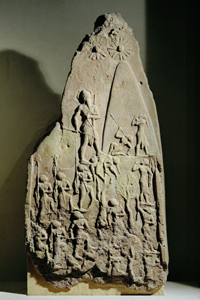Conference to explore interplay of government, religion in ancient Mesopotamia and beyond
By William HarmsNews Office
 Naram-Sin—carved into this victory stele in the top position above his soldiers—wears a horned headdress that denotes divinity. He was the first Mesopotamian ruler to declare himself divine. He reigned some time in the 23rd century B.C. According to his own inscriptions, it was the people of the city of Akkad who wished him to be their god. | |
The relationship between government and religion in ancient times will get careful examination at a symposium titled “Religion and Power: Divine Kingship in Ancient Mesopotamia and Beyond.”
The symposium sessions, which are free and open to the campus community, will begin at 9 a.m. on both Friday, Feb. 23 and Saturday, Feb. 24, in Breasted Hall at the Oriental Institute.
“The interplay between religion and government is something we think of as having a contemporary meaning, but the connections go back very far in time,” said organizer Nicole Brisch, a Post Doctoral Scholar in the Oriental Institute. Brisch, an Assyriologist and Sumerologist, is a specialist in Sumerian royal literature and divine kingship in ancient Mesopotamia.
Among the earliest civilizations to be ruled by kings who considered themselves gods were early Mesopotamia and ancient Egypt. However, other civilizations, such as the Mayan culture in the New World, early China, Ghana and the Roman Empire, also built the concept of divine rule into their cultures. Scholars with specialties in these cultures will speak at the conference.
“We intend to have specialists from many fields, including anthropology, archaeology, art history, linguistics and religion,” Brisch said. “The cross-cultural and anthropological comparisons we discuss will enhance our understanding of divine kingship as an important way these rulers once bolstered their power and created new ideological foundations to support their growing political expansionistic tendencies.”
The first Mesopotamian ruler who declared himself divine was Naram-Sin of Akkad. Naram-Sin reigned sometime during the 23rd century B.C. “According to his own inscription, the people of Akkad wished him to be the god of their city. This first instance of self-deification also coincides with the ‘first world empire’ of the rulers of Akkad, the first time that a dynasty established a territorial ruler over large parts of Mesopotamia,” she said.
Divine kingship took many forms as it was used to consolidate power in ancient states. In Ghana, for instance, an installation rite was performed to transform an ordinary person into someone sacred with magical powers. In the Mayan culture, the divine ruler was associated with a cult of a maize god. In Roman times, emperors were elevated to divine status during their lifetimes.
The Friday sessions will begin with a panel that will discuss the topic “Divine Kingship in Mesopotamia and Egypt.” This session will be followed by another, titled “Iconography and Anthropology of Divine Kingship,” which will begin at 1:30 p.m. On Saturday, a session will be held at 9 a.m. on “Divine Kingship and Imperialism.”
A full schedule for the conference is available at http://oi.uchicago.edu/OI/PROJ/SYMPOSIA/2007.html
![[Chronicle]](/images/sidebar_header_oct06.gif)